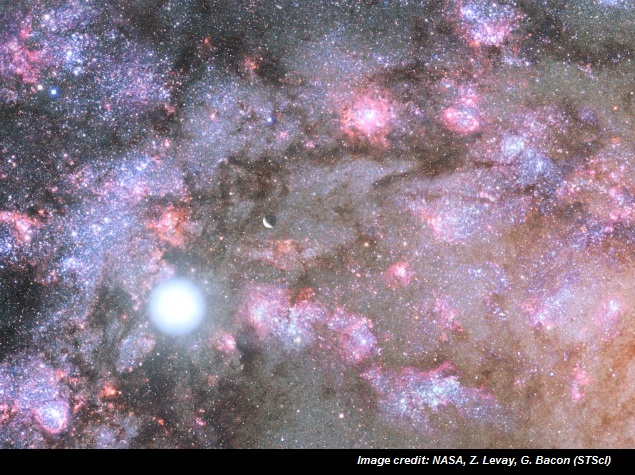- Home
- Science
- Science News
- Nasa Catches Glimpse of How Galaxies Are Formed
Nasa Catches Glimpse of How Galaxies Are Formed

The building site, dubbed 'Sparky', is a dense galactic core blazing with the light of millions of newborn stars that are forming at a ferocious rate.
"We really had not seen a formation process that could create things that are this dense," said Erica Nelson from Yale University in New Haven, Connecticut.
'Sparky' produced roughly 300 stars per year, compared to the 10 stars per year produced by our Milky Way.
It is like a medieval cauldron forging stars with lot of turbulence and it is bubbling.
Astronomers theorise that this frenzied star birth was sparked by a torrent of gas flowing into the galaxy's core while it formed deep inside a gravitational well of dark matter - invisible cosmic material that acts as the scaffolding of the universe for galaxy construction.
The combined observations from Nasa's Hubble and Spitzer space telescopes, the WM Keck Observatory in Mauna Kea, Hawaii and the European Space Agency's Herschel space observatory led to the discovery.
The team also scanned infrared images from Spitzer and Herschel, which allowed them to see how fast the galaxy core is creating stars.
"The discovery settles the question of whether this mode of building galaxies actually happened or not," concluded team-member Pieter van Dokkum of Yale University.
The study appeared in the journal Nature.
Catch the latest from the Consumer Electronics Show on Gadgets 360, at our CES 2026 hub.
Related Stories
- Samsung Galaxy Unpacked 2025
- ChatGPT
- Redmi Note 14 Pro+
- iPhone 16
- Apple Vision Pro
- Oneplus 12
- OnePlus Nord CE 3 Lite 5G
- iPhone 13
- Xiaomi 14 Pro
- Oppo Find N3
- Tecno Spark Go (2023)
- Realme V30
- Best Phones Under 25000
- Samsung Galaxy S24 Series
- Cryptocurrency
- iQoo 12
- Samsung Galaxy S24 Ultra
- Giottus
- Samsung Galaxy Z Flip 5
- Apple 'Scary Fast'
- Housefull 5
- GoPro Hero 12 Black Review
- Invincible Season 2
- JioGlass
- HD Ready TV
- Laptop Under 50000
- Smartwatch Under 10000
- Latest Mobile Phones
- Compare Phones
- Honor Win RT
- Honor Win
- Xiaomi 17 Ultra Leica Edition
- Xiaomi 17 Ultra
- Huawei Nova 15
- Huawei Nova 15 Pro
- Huawei Nova 15 Ultra
- OnePlus 15R
- Asus ProArt P16
- MacBook Pro 14-inch (M5, 2025)
- OPPO Pad Air 5
- Huawei MatePad 11.5 (2026)
- Xiaomi Watch 5
- Huawei Watch 10th Anniversary Edition
- Acerpure Nitro Z Series 100-inch QLED TV
- Samsung 43 Inch LED Ultra HD (4K) Smart TV (UA43UE81AFULXL)
- Asus ROG Ally
- Nintendo Switch Lite
- Haier 1.6 Ton 5 Star Inverter Split AC (HSU19G-MZAID5BN-INV)
- Haier 1.6 Ton 5 Star Inverter Split AC (HSU19G-MZAIM5BN-INV)

















